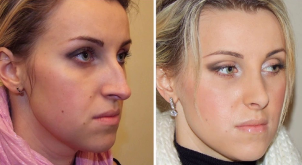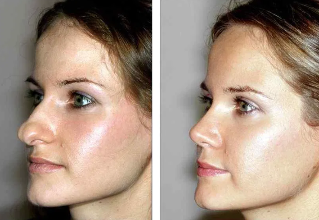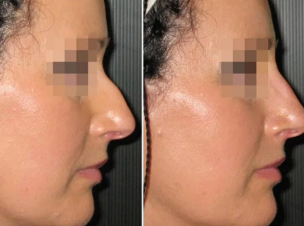Rhinoplasty is one of the most popular plastic surgeries that involve the manipulation of the nose. The objective of this procedure is to restore the proper shape of the nose, which was broken as a result of an injury, disease, or congenital abnormality.
The history of the development of the

You may think that rhinoplasty is the most recent invention and use of the services, surgeons completely alone to the stars, and models. This is not the case. The first mention of the technique of the processing of the face dates back to ancient times. Similar to the operations carried out in India for a 1000 years B.C. the Indian doctors had repaired the damaged nose on your skin from the cheek of the patient.
In Europe, the rhinoplasty was developed in the Middle ages. The Italian surgeons have described my own method to reproduce the shape of the nose from the skin of the face. 19. of the century, this type of surgery has gained a new momentum, thanks to the efforts of the English and German physicians. There are new methods, which are based on the experience of Indian surgeons.
At first, it was the purpose of the rhinoplasty is the repair of the nose, cosmetic, and aesthetic factors that have gained importance in the late 20. of the century.
The medical indications for a rhinoplasty
All of the plastic surgery may be referred to as the creative process, and rhinoplasty is no exception. It combines the solutions to the aesthetic problems with the recovery or maintenance of function of the organ (a normal nasal breathing).
For that reason, this procedure may be carried out both in the therapeutic and cosmetic use. Your best bet is to do the surgery at the age of 25-30 years of age, when the cartilage is fully developed. Of course, the recommended age may vary depending on the circumstances of the particular case.
Medical indications:
- Violation of nasal breathing, or the complete lack of it.
- Traumatic injuries, which led to the change, and the deformation of the cartilage and the bone.
- That the developmental, physiological, and compensatory curvature of the nasal septum.
- Congenital curvature or deformity of the nasal septum.
- Cysts and polyps in the nose.
- Hypertrophy of the turbinates.
Abnormalities in the anatomical structure of the nose can lead to a variety of functioning problems and disease conditions. This can include: otitis media, rhinosinusitis, asthma, snoring, frequent respiratory infections, atrophy, or hypertrophy of the membrane in the nose, difficulty in nasal breathing.
Especially dangerous violation of the nasal breathing children. This can lead to oxygen starvation of the brain, leading to mental and physical developmental delays. The operation to restore the respiratory function can be assigned to up to 18.
Surgical indications for rhinoplasty
More than half of the business to change the shape of the nose done for cosmetic reasons. The patients want to achieve harmony in your appearance. Surgical indications for a plastic surgery, it can be divided into two sub-categories:
- Target. When the nose is disproportionate in size, shape.
- Subjective to the individual. This group is composed mainly of psychological reasons related to the assessment of their physical appearance. For example, a patient such as a small club, or upturned.
The psychological causes are often related to a professional or social environment. The patient has the complexes, the acute dissatisfaction with their own appearance.
The aesthetic of particulars:
- Is a deviated septum.
- Acquired and congenital deformities.
- The disproportionate size relative to the face, while the nose appears too large or too small.
- The nose, the shape of the.
- Bump.
- Too wide and the nostrils.
- Unattractive form, and when the tip of the nose of a forked, lowered, raised, thickened, or not.
- An asymmetrical nose.
- Address the consequences of the failed rhinoplasty.
It is important to understand that it is the result of the operation is not always possible to get a perfect score. In operation, however, there are some limitations, therefore, the rhinoplasty has to be considered as a revision to an existing form.
Contra-indications

Prior to the surgery, many patients are advised to see a psychologist. There are some cases where the patient has a normal shape to the nose without any cosmetic or functional problems. Then the problem will be solved by working with a psychologist.
Plastic surgeons can produce a particular measurement, and to say whether there are any errors. There are some parameters by which to assess how the shape of the nose and the harmony of its position with respect to the head, the eyes, the mouth, the chin, the ears. On the advice of a doctor, you can simulate on the computer of the alleged look at the device.
Contra-indications:
- The age limits. The surgery is not recommended before 18 to 40 years. This limitation may be removed due to objective reasons.
- Diabetes mellitus, a disease of the kidneys, the liver, the heart and the circulatory system.
- Folliculitis and acne in the nose area.
- The coagulation of the blood.
- Oncology.
- Mental ill-health.
- During the period of menstruation.
Types of rhinoplasty
In light of the objectives and techniques of the implementation of the surgery for rhinoplasty is divided into a number of types.
The goals for rhinoplasty may be:
- To reconstructive. The processing of the violation that has occurred due to a disease, injury, failure, and the development of a fetus.
- Aesthetic. This is a correction of cosmetic defects.
At the time of operation can be carried out:
- An increase or decrease in the nose.
- Elimination of the hump.
- The correction to the nose of the saddle shape, that is, the elimination of the gap.
- The correction of the shape of the tip of the nose.
- Septoplastike (that is, the correction of the nasal septum).
- Post-traumatic reconstruction.
According to the method of access operation can be opened and closed. A private method that is used in cosmetic surgery as it is less traumatic. In this case, all of the incisions are inside the nasal cavity. The skin is separated from cartilage, and the surgeon can easily adjust the form to work with the bones and the cartilage tissue to remove the excess or increased by the implant. After manipulating the breakdown of a beautifully made.
Open rhinoplasty is used in difficult cases, to correct serious changes, and the implementation of large-scale transactions. A Cut is made in the skin crease between the wings of the nose. In this case, the surgeon gets access to the tissues, cartilage, and bone. Treatment through this method may take a long period of time, there is still a noticeable postoperative scar.
Non-surgical rhinoplasty
Non-surgical rhinoplasty is an alternative to the surgical procedure. However, there are ways to eliminate the small mistakes.
Rhinoplasty with fillers (cosmetic gel), it will help to remove minor imperfections, soften sharp angles, restoring symmetry to change the shape of the tip. The use of fillers allows you to conceal a small punch to remove the hollowness, to round off the tip.
The period of recovery after surgery is easier, the cost is low in comparison with the full-fledged operation. However, the effect of the charges will be continued only for a few months (maximum 1.5 year). In some cases, the injection-formed fibrous tissue, and the external effect of the procedure lasts for a number of years. However, they often require a second procedure. There is a complication: the migration is introduced to the gel, and the change in the structure of goods after repeated injections.
With the help of injections not only increase, but also the removal of the tissue. There are preparations on a hormonal basis, which can eliminate the bumps, bulges, and even, in some cases on a hump. With the introduction of these drugs, it is very important to be careful. Often, the process is carried out in several stages. After 2-3 weeks, it will be important to the outcome.
With the help of a specific issue, you can adjust the shape of the wings, the nose and even pull it up to the tip. Set the thread through the holes, which can form scar tissue. The thread may break due to the mobility of the nose. For all of these reasons, surgeons rarely resort to such a procedure.

Preparation for the operation of the
For the success of the operation required the cooperation of the patient and the doctor. Prior to the surgery in the consultation, where your surgeon will explain to the patient that he is going to achieve the result you want.
Completed General studies: blood count, coagulation studies, urinalysis, EKG, stress tests for HIV, hepatitis, syphilis.
If it is necessary, to carry out a special study of it. If you have a chronic illness, you should consult with a GP or an appropriate specialist. The surgery will be postponed in the event of a deterioration of the chronic disease, the occurrence of acute respiratory diseases, or infectious skin lesions. Prior to the surgery, you will meet with an anesthesiologist.
Your doctor may recommend that you abstain from alcohol, Smoking cessation, eliminate junk food, stop taking any sleeping pills, and tranquilizers. Two weeks prior to the surgery it is necessary to stop taking aspirin and its equivalents.
Complications
Rhinoplasty is one of the most complex plastic surgery as an important aesthetic and functional side. Complications can occur, depending upon a variety of factors in 4-15% of patients. They can be divided into the operational and after-care.
Operational problems:
- bleeding;
- breaks in the skin;
- the violation of the integrity or the fracture of the bone;
- the separation of the cartilage flap, etc.
Postoperative complications:
- loss of smell;
- the loss of, or reduction in the sensitivity of the nose and the lower lip;
- the obstruction of nasal breathing;
- atrophic rhinitis;
- the deterioration of the correct cosmetic defects, and lack of change.
- psychological problems (a patient does not accept the change in looks, he doesn't like the new face);
- swelling of the nose and the eyelids, inflammation, suppuration;
- pigmentation of the skin, scar formation, capillary network;
- frequent or prolonged nosebleeds;
- necrosis.
The most dangerous complication that can occur during the rhinoplasty it is an allergic reaction to the anesthesia. Anaphylactic shock can cause death in 20% of cases.
The recovery of the
The patient can leave the hospital within a few hours after the surgery or stay overnight for observation. The main recovery after the repair of the nose for 3 weeks now. A full recovery will come only after a period of six months or for a period of one year.
The seams and plaster Longuet will be removed in 1.5 weeks. Another 2 weeks and won't be able to take a hot bath, wash your face with warm water – this can lead to bleeding, bruising, swelling of the face and neck. Need to sleep on your back a reclining. You can't bend, lift weights. In dusty areas should wear a mask.
Within three months, should be thoroughly shielded from bumps, and the pressure on the nose, does not wear glasses, a mask, a helmet. It is strictly forbidden to use the swimming pool and sunbathing area. The surgeon may also impose any other restrictions imposed by the individual, the health status of the patient.
The results of the operation of the
The treatment of cartilage and bone tissue will take a couple of months. The end result was the surgeon, and the patient will be able to assess, after about 8 months. The decision to do rhinoplasty (especially if you don't, you'll have abundantly clear is the witness) may be perceived to be negative and, therefore, the patient should be prepared for mixed reactions from your family and friends.
Relatives may be unhappy with the loss of his family, or ethnic characteristics. However, it is often the patient himself and his family, and I do not see much effect of such an operation, because the swelling hides the changes that occur over time.
Rhinoplasty is a quite capable, if you want to change the look, but do not assume that plastic surgery is possible without the limitation of the model is to all of us in the fantasy. Any surgery is a dangerous thing to do, which can lead to complications and even worsening the injury. Therefore, for the treatment of such intervention should be seriously, carefully weighing the possible benefits and the risks of adverse effects.






















